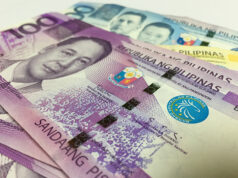Peso recovers on hawkish BSP
THE PESO rebounded slightly versus the dollar on Friday, even as it almost hit the P54 level intraday, following the local central bank’s hint of another rate hike this month.
The local unit ended the week at P53.73 against the greenback, seven centavos stronger from Thursday’s finish of P53.80.
The peso opened the session weaker at P53.85 versus the dollar and slipped to as low as P53.975 intraday. Its best showing, on the other hand, stood at P53.61 per dollar.
Trading volume was slightly higher at $956.9 million from the $911.5 million that switched hands the previous day.
A trader said the peso saw “very choppy trade” on Friday as it opened the session weaker.
“We traded [weaker] at the morning trade as we continued the momentum [on Thursday],” the trader said in a phone interview. “However, the comments from the BSP (Bangko Sentral ng Pilipinas) Governor pushed it [stronger].”
In a mobile phone message, BSP Governor Nestor A. Espenilla, Jr. said on Friday the monetary authority will “take strong immediate action” using the full range of instruments to respond to the emerging threats to inflation and inflation expectations.
“The follow-through actions will also address other threats to higher inflation such as excessive exchange rate volatility not consistent with underlying macroeconomic fundamentals in order to ensure that inflation returns to its 2-4 percent target over the policy horizon,” Mr. Espenilla said Friday.
Asked whether the Monetary Board may meet ahead of the Sept. 27 to address these issues, Mr. Espenilla said: “That’s an option. We’ll see.”
Inflation accelerated to a fresh nine-year high of 6.4% in August, faster than July’s 5.7% and the 2.6% in August 2017, due to higher oil and food prices.
It pierced the 5.5-6.2% estimate range given by the BSP’s Department of Economic Research as well as the 5.9% median in a BusinessWorld poll among 14 economists.
“[The pronouncements of Gov. Espenilla] drove the market today, even the offshore market was pushed [stronger],” the trader said on Friday.
Mr. Espenilla added that the BSP will reactivate tools such as the Currency Rate Risk Protection Program facility which will be made available to eligible corporates with foreign exchange obligations based on more liberalized rules to crackdown speculative activities by market participants.
“The directive basically discourages hedging as it sometimes makes currencies either cheaper or more expensive,” Ruben Carlo O. Asuncion, chief economist at UnionBank of the Philippines, explained. — Karl Angelo N. Vidal



